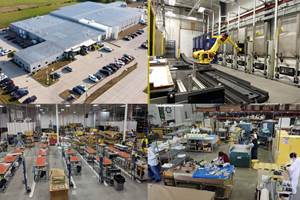DSM Dyneema, Airborne International collaborate on radomes
DSM Dyneema works with Airborne International to apply DSM technology to a ground-based radar system that requires durability, electromagnetic transparency and high strength.
DSM Dyneema (Herleen, The Netherlands; Greenville, NC, US), manufacturer of ultra high molecular weight polyethylene (UHMWPE) fiber, branded as Dyneema, has formed a partnership with Airborne International (The Hague, The Netherlands) to develop and produce radomes featuring Dyneema Crystal Technology.
With what DSM Dyneema says is near-zero signal loss, Dyneema Crystal Technology is setting new standards for electromagnetic transparency, as well as light weight, strength and hydrophobic performance. The partners will deliver next-generation radomes to companies including initial customer Pro Patria Electronics (Budapest, Hungary) for its PGSR-3iFT Beagle tower-mounted ground surveillance radar.
“Our tower-mounted ground surveillance radar faces tough, unrelenting challenges in the field,” says Miki Kohen, technical director of Pro Patria Electronics. “We needed a breakthrough radome design to support and enhance its capabilities and we found the ideal solution by working with Airborne and DSM Dyneema. Dyneema Crystal Technology not only exceeded our high expectations for performance, but it also addressed a wide spectrum of challenges, from protection to portability. This unique material has the potential to transform our industry in a big way.”
The Pro Patria PGSR-3iFT Beagle is a tower-mounted radar used to detect, track and classifiy targets moving on or close to the ground. Designed for deserts and other harsh environments, it is a key component of sensor systems for early warning, border incursion prevention and threat recognition. The cylindrical radome developed by DSM Dyneema and Airborne for this application uses high-performance Dyneema Crystal Technology in tape form and is approximately 1m in diameter and 1.2m in height.
“Dyneema Crystal Technology takes a radically different approach to radar protection, enabling us to raise the bar in radome design and production,” says Giel van der Kevie, commercial manager of Airborne International. “This technology gives our company a powerful new solution to address higher frequency challenges and requirements for near-zero signal loss. Together with our partner, DSM Dyneema, we are investigating new ways to leverage the distinctive properties of Dyneema Crystal Technology to benefit our customers.”
“Our Premium Manufacturing Partnership with Airborne International will enable us to offer radically new designs to the radomes industry,” says Danielle Petra, business development manager at DSM Dyneema. “Drawing on our complementary strengths and shared focus on innovation, we are leveraging Dyneema Crystal Technology to re-imagine radome capabilities and maximize radar performance.”
Dyneema says its Crystal Technology provides an extremely low loss tangent and approximately half the dielectric constant compared to aramid, E-glass and quartz. The electrical properties of the material maintain superior performance, even at higher frequencies from X band to millimeter band, allowing military, civil and telecommunications organizations to realize the full potential of their advanced antenna, radar, radio astronomy or communications systems.
Further, because Dyneema Crystal Technology offers an exceptional strength-to-weight ratio and high impact resistance, it can be used in thinner gauges that enhance transmission quality even more. Its light weight also makes radomes more energy-efficient to ship and easier to maneuver and install.
The material, which can be supplied as tape or fabric, is inherently hydrophobic without the need for time-consuming and demanding resin application. This property also virtually eliminates the need for regular maintenance.
Related Content
Combining multifunctional thermoplastic composites, additive manufacturing for next-gen airframe structures
The DOMMINIO project combines AFP with 3D printed gyroid cores, embedded SHM sensors and smart materials for induction-driven disassembly of parts at end of life.
Read MorePlant tour: Sekisui Aerospace, Orange City, Iowa, Renton and Sumner, Wash., U.S.
Veteran composites sites use kaizen and innovation culture to expand thermoplastic serial production, 4.0 digitization and new technology for diversified new markets.
Read MoreMFFD longitudinal seams welded, world's largest CFRTP fuselage successfully completed
Fraunhofer IFAM and partners have completed left and right welds connecting the upper and lower fuselage halves and sent the 8×4-meter full-scale section to ZAL for integration with a cabin crown module and testing.
Read MorePlant tour: Collins Aerospace, Riverside, Calif., U.S. and Almere, Netherlands
Composite Tier 1’s long history, acquisition of stamped parts pioneer Dutch Thermoplastic Components, advances roadmap for growth in thermoplastic composite parts.
Read MoreRead Next
Ultrasonic welding for in-space manufacturing of CFRTP
Agile Ultrasonics and NASA trial robotic-compatible carbon fiber-reinforced thermoplastic ultrasonic welding technology for space structures.
Read MoreCeramic matrix composites: Faster, cheaper, higher temperature
New players proliferate, increasing CMC materials and manufacturing capacity, novel processes and automation to meet demand for higher part volumes and performance.
Read MoreCutting 100 pounds, certification time for the X-59 nose cone
Swift Engineering used HyperX software to remove 100 pounds from 38-foot graphite/epoxy cored nose cone for X-59 supersonic aircraft.
Read More












